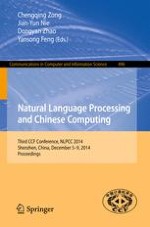2014 | Buch
Natural Language Processing and Chinese Computing
Third CCF Conference, NLPCC 2014, Shenzhen, China, December 5-9, 2014. Proceedings
herausgegeben von: Chengqing Zong, Jian-Yun Nie, Dongyan Zhao, Yansong Feng
Verlag: Springer Berlin Heidelberg
Buchreihe : Communications in Computer and Information Science
